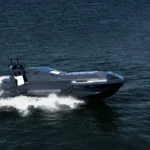UAVOS has announced a successful flight demonstration of its S1V300 Medium Altitude Long Endurance (MALE) unmanned aerial system (UAS), emphasizing significant gains in fuel efficiency and endurance. The platform is designed for long-range ISR missions and border surveillance, offering modular payload options and autonomous operation capabilities.
Flight Test Highlights Endurance and Fuel Economy
The recent flight test saw the S1V300 complete a mission profile that lasted over 16 hours at altitudes up to 7,000 meters (23,000 feet), showcasing its ability to deliver persistent coverage across large operational areas. According to UAVOS, the aircraft consumed just 19 liters of aviation gasoline per hour during cruise—an impressive figure for a platform in the MALE class.
This performance positions the S1V300 as a cost-effective solution for extended ISR operations where fuel logistics are often a limiting factor. The aircraft’s internal combustion engine is optimized for high-altitude cruise efficiency while maintaining sufficient payload capacity.
Design Features Tailored for ISR Missions
The S1V300 features a high-aspect-ratio wing design with composite construction optimized for aerodynamic efficiency. Its wingspan exceeds 12 meters, contributing to lift-to-drag ratios that support long-endurance loitering at medium altitudes.
The airframe integrates modular payload bays capable of housing EO/IR gimbals, synthetic aperture radar (SAR), communications relays, or electronic intelligence (ELINT) sensors. UAVOS reports that the standard configuration includes a stabilized EO/IR turret with real-time video downlink capability over encrypted datalinks.
Autonomy and Ground Control Architecture
The S1V300 is equipped with UAVOS’ proprietary autopilot system supporting fully autonomous taxiing, takeoff, mission execution, and landing. GNSS-denied navigation modes are also supported via inertial navigation systems (INS) fused with terrain-following algorithms.
Ground control is managed through UAVOS’s advanced GCS suite featuring dual redundant communication links (SATCOM optional), mission planning software with dynamic re-tasking capabilities mid-flight, and real-time telemetry monitoring. The GCS supports integration into C4ISR networks via open architecture protocols such as STANAG-4586.
Target Use Cases: Border Patrol to Maritime Surveillance
Given its endurance profile and modest logistical footprint compared to larger HALE platforms like MQ-9 Reaper or Heron TP, the S1V300 is positioned for missions including:
- Border surveillance in remote or mountainous terrain
- Maritime domain awareness over EEZs
- Counter-smuggling and anti-piracy patrols
- Tactical ISR support for ground forces in semi-permissive environments
- Infrastructure inspection or disaster response coordination
The system’s ability to operate from semi-prepared runways or even catapult launchers broadens its deployment options in austere locations.
Comparison with Peer Systems
The S1V300 competes in a crowded MALE segment populated by platforms such as:
- Mantis GCS’s Vector-M: Similar endurance but heavier logistical footprint due to diesel propulsion.
- Taiwan’s Teng Yun II: Offers SATCOM integration but lacks modularity in payload bay design.
- Anka-S by Turkish Aerospace: Superior range via SATCOM but higher acquisition cost and infrastructure needs.
- Aeronautics’ Orbiter-4: Smaller payload capacity but easier tactical deployment via catapult launcher.
S1V300’s niche lies in balancing long-endurance performance with relatively low operating costs and flexible deployment models—a combination attractive to nations seeking ISR capabilities without full-scale HALE infrastructure investment.










